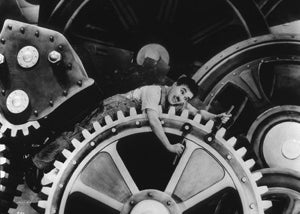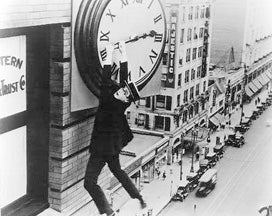
Cultural and Scientific Attitudes Towards Time
(under construction)
Western culture is obsessed with reducing the time it takes to achieve results of all kinds. We expect newly designed cars to roll off the assembly line every 12 months; we want to purchase and eat "fast food" quickly; we are obsessed with lottery winners and others who "get rich quick." We expect goods and services in "a New York minute"...not the "3/4" time of yester-year.
Even our this in our choice of metaphors--a "New York minute" is VERY fast compared to the "3/4 time" of many Southerners who value a more leisurely pace of living.
Taylorism was a series of techniques for improving the efficiency of manufacturing processes of all kinds. Developed by the "father of scientific management," Frederick Winslow Taylor (1856-1915), the goal was to reduce the amount of time it took to produce certain goods and services. Taylor, who came from a well-to-do Philadelphia family, was a foreman in a Pittsburgh steel mill. He devised a means of detailing a division of labor in time-and-motion studies and a wage system based on performance. The negative consequences of carrying such attitudes to extremes was pilloried by Charlie Chaplin in the famous film, Modern Times (1936).
Charlie Chaplin on the film set of Modern Times (1936) Photo by Max M. Autrey, Image courtesy MPTV.net
"Taking Taylorism to an extreme was Henry Ford, who pioneered mass production with the world's first assembly line. Productivity was king in Ford's assembly line and the human workers were not much more than mechanical components, subject to monitoring and control too. Charlie Chaplin's classic film Modern Times(1936)was a vivid satire on the effect of mass production on the factory worker, who was regimented, bored, frustrated and eventually provoked to strikes and revolts."(footnote_Taylorism)
(footnote_Taylorism) http://personal.ie.cuhk.edu.hk/~wyng/gee/efficiency.html
Clocks and Keeping Time

Still from the movie Safety Last (1923), starring Harold Lloyd
"Lloyd's eleven silent features eventually established him around the world as a symbol of ingenious American youth and vigor and to this day, his astonishing stunts and gags (most indelibly, Lloyd hanging on for dear life to the hands of a clock precariously attached to a skyscraper) remain a lasting contribution both to American culture and to the international art of film comedy."
http://www.pancakeparlour.com/History/GiantClock/giantclock.html
Analog vs. Digital
To access this web-based clock--a digital clock created by sequencing hand-drawn (analog)numbers--click the image above or go to: http://www.yugop.com/ver3/stuff/03/fla.html
How Scientists Measure Time
Nano-second
Pico-second
Real Time is a term originally from Computer Science denoting the actual and constant unfolding of time against which various computer processes are measured.
real time n : (computer science) the time it takes for a process under computer control to occur From Jargon File (4.3.0, 30 APR 2001) (jargon) real time 1. [techspeak] adj. Describes an application which requires a program to respond to stimuli within some small upper limit of response time (typically milli- or microseconds). Process control at a chemical plant is the {canonical} example. Such applications often require special operating systems (because everything else must take a back seat to response time) and speed-tuned hardware. 2. adv. In jargon, refers to doing something while people are watching or waiting. "I asked her how to find the calling procedure's program counter on the stack and she came up with an algorithm in real time."
Cosmic Time
Carl Sagan, in his book, The Dragons of Eden, packs the duration of the universe into a 365-day year. The time from the Middle Ages to the present lasts but a second. Imagine the fifteen-billion-year lifetime of the universe compressed into the span of a single year. Then every billion years of Earth history would correspond to about 24 days of our cosmic year and one second to 475 revolutions of Earth around the sun.
See also: http://www.internettime.com/itimegroup/cosmiccalendar.htm

A quasar--Site of the birth of the Universe?
See: http://oposite.stsci.edu/pubinfo/StarCatcher/1stServicing/Postcards.html
Evolution and Metamorphosis

Geologic Time
Certainly part of the fascination with sites of natural splendor such as the Grand Canyon is the tremendous insights they give us into the passage of time. Geologic time has come to mean the kind of time frame necessary to gain a grasp of otherwise unimaginable stretches of time that comprise the history of the planet. A popular technique for putting our own sense of time in perspective is to make a comparison between an hour of the day to the length of time it has taken to create massive geological features such as the Grand Canyon.
One Hour in the Life of the Universe
Culture and Symbols of Time
Other examples of symbolic time include important cultural icons such as the BOOK OF GENESIS WITH ITS SIX DAYS OF CREATION, THE "Stations of the Cross" in Christian iconography, or the "life of the Buddha" as indicated in architectural sculpture or mandala painting.
INSERT IMAGE OF GOD "CREATING THE HEAVENS AND THE EARTH..."
INSERT CHRISTIAN BYZANTINE PAINTING SHOWING STATIONS OF THE CROSS
INSERT EXAMPLE OF THE TEMPLE AT BOROBUDUR IN WHICH THE LIFE OF BUDDHA IS DEPICTED SYMBOLICALLY AS A SERIES OF LITERAL "STEPS" TO ENLIGHTENMENT.